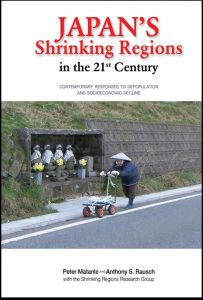Memo #240
By Anthony S. Rausch – asrausch [at] cc.hirosaki-u.ac.jp

Japan faces an aging population and rural out-migration, a sluggish economy and drastic divisions between urban-rural economies, a critical techno-environmental catastrophe and vital debates regarding energy policy. A bleak set of problems, but also a fair representation of some of the issues the world is coming to face, meaning Japan may well serve as a global test case for our new age.
Detailed analyses of Japan’s rural socio-demographics reveal a narrative of an aging population, out-migration and depopulation, and economic stagnation. Predominantly a post-1990s phenomenon, in some places these trends have been exacerbated rather than relieved by the recent Heisei Municipal Mergers, which halved the number of Japan’s municipalities—from over 3,200 to about 1,700. The 3.11 triple earthquake-tsunami-nuclear disaster shook the entire nation to its core, and has left behind an isolated and desolated Tohoku District coastal area in its wake.
Yet, there are stories from various areas throughout Japan that reveal a local stability amidst the chaos. As conventional policy responses confront realities geological, geographical, social and economic, my observations are that places and people of rural Japan are confronting and accepting a new consciousness of ‘place’ and ‘place recovery.’ Place-consciousness can be seen in the local kentei phenomenon, in which ordinary residents pass ‘local knowledge’ tests and gain official certifications as experts on their city or prefecture. My local Aomori Prefectural newspaper, the Toonippo, details the population decline and economic stagnation of our prefecture on the one hand, while on the other carrying long-running serial columns about how to grow our local economy based on local economic realities. A nationally syndicated column emerging out of the 3.11 triple disaster focuses on the human response to the calamity, building a new public memory of the event under the guise of ‘New Japanese Happiness.’
Central to recognizing these trends is the reality that knowing what is happening in local places is often more telling than having a view of national politics or policy. Ultimately, it is in these local places that the character of our new age will be determined.
About the Author:
Anthony S. Rausch is a professor at Hirosaki University, Japan.

A multi-thematic study of rural Japan titled Japan’s Shrinking Regions in the 21st Century, co-authored by Peter Matanle and Anthony S. Rausch (Cambria Press, 2011).
Links:
- Japan’s Shrinking Regions in the 21st Century: Contemporary Responses to Depopulation and Socioeconomic Decline, by Peter Matanle and Anthony S. Rausch (Cambria Press, 2011)
- Japan’s Local Newspapers: Chihoshi and Revitalization Journalism, by Anthony S. Rausch (Routledge, 2012)
- Bridget Love, “Treasure Hunts in Rural Japan: Place Making at the Limits of Sustainability,” American Anthropologist vol. 115, no. 1 (March 2013)
- Gotochitsu, website about Japan’s area kentei examinations (in Japanese)
- Toonippo newspaper in Aomori Prefecture (in Japanese)
Related Memos:
- See our other memos on Japan
Comments are closed, but trackbacks and pingbacks are open.